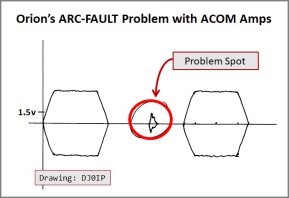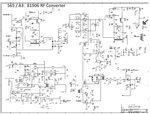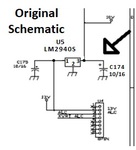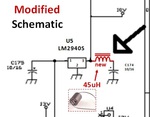Orion/Acom ARC-FAULT PROBLEM/FIX
The following information only applies to:
- ORION-1 (not ORION-2)
- CW Mode (not SSB . . . but maybe some digital modes)
This problem originated in late 2004 / early 2005.
PROBLEM DESCRIPTION:
When interfacing the Orion-1 with any ACOM linear amplifier, and using the 2-cable amp-key interface for full-QSK keying, the ACOM amp often (and regularly) trips its "ARC-FAULT" line and places the amplifier into standby mode.
In 2005, after long researching by Ten-Tec and ACOM jointly - along with 3 or 4 users*, the cause of the problem was found and a "Field Fix" was created. The fix was to supply all customers who owned an ORION-1 and ACOM amplifier with a high-pass filter which suppressed signals below 1.6 MHz.
Customers were happy, the Orion-2 soon announced and it no longer had this issue.
The "Field Fix" was not actually a fix, it was just a crutch; a bandaid to mask/patch the problem and enable the two divices to work seemlessly together without triggering ARC-FAULT.
*DJ0IP, N1EU, SM6CNN, & UA3AP (apologies if I forgot someone).
THE CAUSE:
Although the rise-time/fall-time of the Orion's CW RF waveform was perfect, it was found that a tiny 1.5v spike was being generated soon after the bit completed.
Though not audible, its signal strength was strong enough to trip the ARC-FAULT circuit in the ACOM amplifier.
After a long search in the Ten-Tec lab, Jach Burchfield determined that the spike was being caused by a noisy +10 vdc regulator on the 81906 RF Converter board.
THE FIX:
In theory, the fix was very simple.
It involved inserting a small RF choke between pin #3 of the regulator IC, U5 (LM2940S), and the hot lead of C174.
To implement this, Jack wrote in his email to me that he lifted the leg of the regulator. I believe that is incorrect. If I recall correctly, I lifted the hot leg of the capacitor, soldered one side of the coke to it, and the other side to pin #3 of the regulator.
That was 13 years ago and it's all kind of foggy now.
UNLESS you are comfortable soldering components on a printed circuit board, you should probably not implement this fix. Instead, use the alternative High-Pass-Filter method.
These filters are no longer available from TEN-TEC but I have tested it and found the DUNESTAR HPF-400 to work just fine.
See photo gallery below for more info.
PHOTO GALLERY:
"Possible" D-i-Y HPF Fix:
In searching through old emails, I came across the information below.
It describes a simple HPF that should fix the problem.
DOWNLOAD:
HISTORY:
Although I owned an ORION at the time, I did not own an ACOM amplifier. I became aware of the problem when some of my friends and fellow contest club members began complaining about it.
I emailed ACOM in Bulgaria and Ten-Tec in Tennessee, asking for help.
I immediately got replies from Stan, LZ1IU (I believe he was Tech Support Manager at the time), and Jack Burchfield, K4JU (the president of Ten-Tec at the time).
We (Stan, Jack, and a few users) worked together on this problem until the cause was found and a fix was made available to the customers/users.
OPINION:
The professionality and determination shown by ACOM and TEN-TEC in solving this problem is a great example of how companies can and should work together. I sincerely doubt that any of the Big-3 'JA companies' would have cooperated like this!
To the best of my knowledge, only two ORIONs ever had the Choke-Mod installed; mine and Jack's. All the rest were fixed with the external HPF.






























